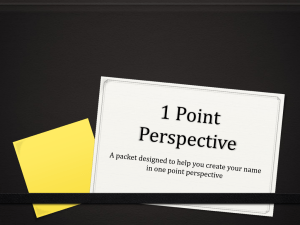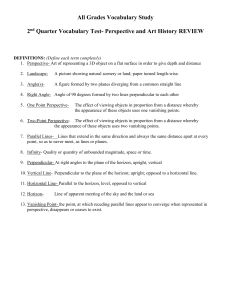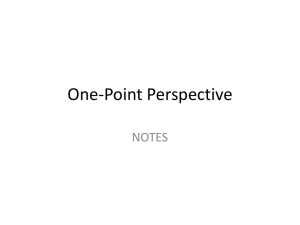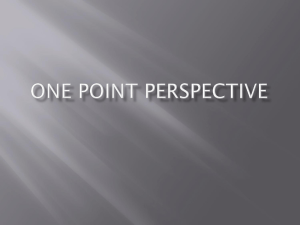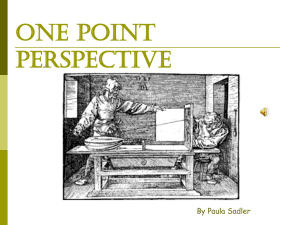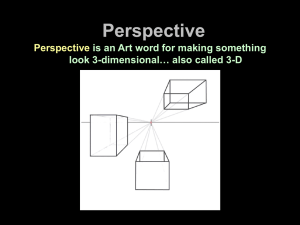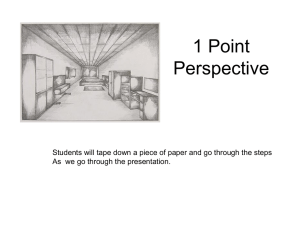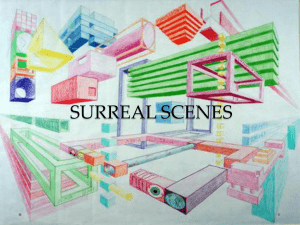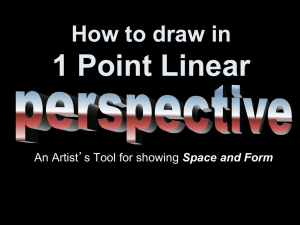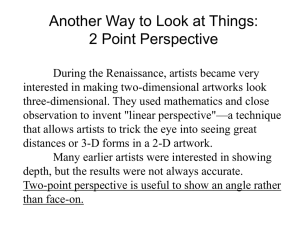Powerpoint - City of Augusta, Maine
advertisement
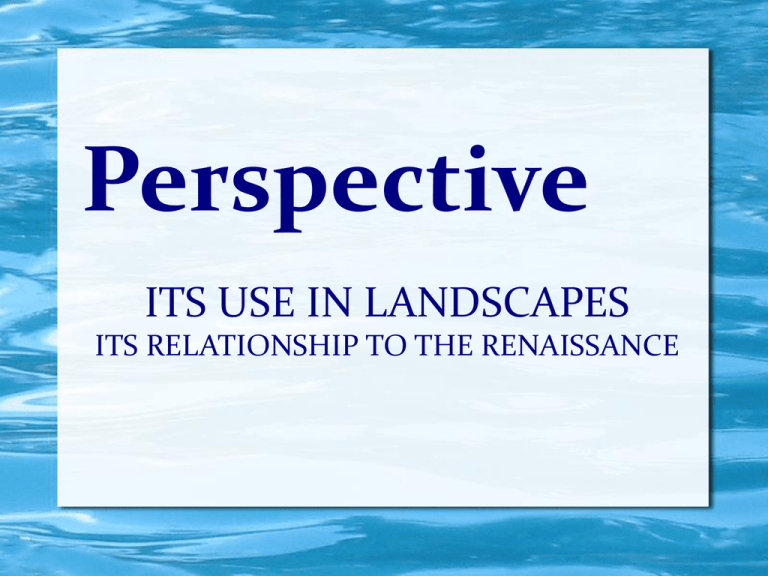
Perspective ITS USE IN LANDSCAPES ITS RELATIONSHIP TO THE RENAISSANCE The Types of Perspective: One Point Perspective A way of showing space using diagonal lines that converge at one point. In this photo, all diagonal lines seem to meet at one spot close to the center. In one point perspective, the spot where every diagonal line meets is called the vanishing point. It is called one point perspective because there is only ONE vanishing point, and it doesn’t necessarily need to be in the center of the page. What do we call the line that separates the sky and the ground? Two Point Perspective In two point perspective, we use two vanishing points. So, the diagonal lines will be pointing to either one of the two vanishing points. Two point perspective is showing us the view from the corner of an object, like a building. An architect and engineer during the Italian Renaissance. His discovery of linear perspective now showed artists how to paint images as three dimensional objects on a two dimensional surface. School of Athens by Raphael What form of perspective is being used here? Notice how all of the diagonal lines point to the two figures in the middle. Raphael did this on purpose to show that these two men, Socrates and Aristotle, are the focus of his painting. • • • What form of perspective is being used here? This is a tricky one!! Look all around… Vermeer has cleverly used both one point and two point perspective. The wall and the table with the rug over it use one point perspective. The floor tiles are in two point perspective. On Perspective Project a 9 X 12 piece of paper, draw a city scape which uses one point perspective Use your ruler Must be done in pencil Make an interesting composition! On a 9 X 12 piece of paper, draw a city scape which uses two point perspective Use your ruler Must be done in pencil ONE POINT PERSPECTIVE, SHAPE ABOVE HORIZON LINE Draw a dot in the Draw a horizontal middle of the line. This is your horizon line. This is horizon line. your vanishing point. Draw a square or rectangle. Make sure the top of the square extends above the horizon line. Erase the horizon line behind the square. Draw two diagonal lines that connect the corners to the vanishing point Erase all lines that are not part of the box. Draw a vertical line to show where the box ends. Notice the line is parallel to all other vertical lines. ONE POINT PERSPECTIVE, SHAPE BELOW HORIZON LINE Draw a horizon line and a dot for a vanishing point in the middle. Draw a square. Make sure the top of the square is below the horizon line. Draw diagonal lines that connect the corners of the square to the vanishing point. Draw a vertical and horizontal line to show where the square ends. Erase any lines that aren't part of the cube TWO POINT PERSPECTIVE, SHAPE ABOVE HORIZON LINE Draw a horizontal line and two dots for vanishing points on either side of the paper. Connect the top and bottom of the vertical line to either vanishing point Draw a vertical line in the middle of your paper. This is the corner of the cube. The line should extend above the horizon line. Draw two vertical lines to show the edges of the building. Erase all lines that are not part of the cube shape. TWO POINT PERSPECTIVE, SHAPE BELOW HORIZON LINE Draw a horizontal line and two vanishing points on either side of the paper. Connect the top and bottom of that vertical line to either vanishing point Draw two vertical lines on either side of your middle line. Draw a vertical line in the middle of your paper. Make sure the line is below the horizon line. Connect the top of those vertical lines to the opposite vanishing point Erase all lines that are not part of the cube shape.
